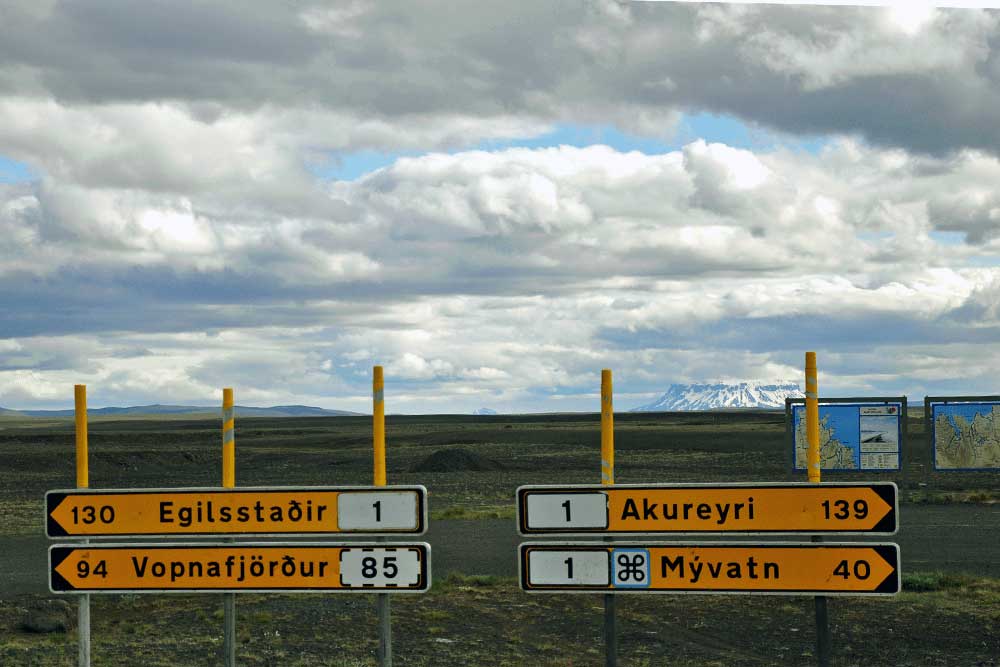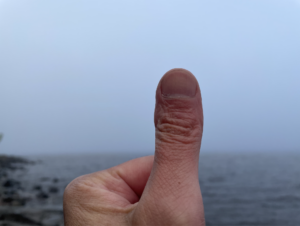
Iceland made author Carter Meland think about how the way we measure can bring us closer to—or further from—the objects in our environment. Flickr Jennifer Boyer (CC BY-ND 2.0)
Driving through Iceland, the foreboding moonscape of the lava fields gives way to the mysteries of mist-shrouded mountain peaks. It is a place where the tumbling beauty of waterfalls spills into volcanic ash beds that seem devoid of life. For someone who comes from the forested, lake-filled, and (largely) flat land of Minnesota, Iceland’s landscape is simultaneously enchanting and alienating. I feel this tension in my body, and the push-and-pull of the place brings me to a minor epiphany about systems that presume progress is achieved through efficiency.
The metric system, used in most countries around the world, is logical and reasonable— but it exists outside our bodies. My experience in Iceland served to remind me how we can measure landscapes against our expectations, our bodies, and our imaginations in ways that may not be logical but use the things that make us human.
Traversing Iceland’s Ring Road in a 1999 Toyota, a GPS-free vehicle, required someone like myself to adjust from familiar miles to strange kilometers. Whenever a road sign reported that some Icelandic town with a mile-long and largely unpronounceable name was 27 kms distant, I would quickly do the mental math—1 mile = 1.6 kms, and so 27 kilometers divided by 1.6 = 17 or so miles—to get an idea of how much time it would take me to get there.
This experience of calculating the strange into the familiar will no doubt be discounted by many who hold that if only I had been born in a forward-thinking country that had long ago adopted the metric system, I would not have to apply a formula memorized in the sixth grade. That perhaps is true, but my objection to the metric system is not rooted in the accident of my birth in the United States. Rather, my objection is to the way it dehumanizes the way we interact with our landscapes.
The metric system was developed in late 18th-century France as a way to standardize measurement; industrialization and European colonialism quickly spread it across the world. When viewed as a component of the universal progress these economic and sociopolitical orders promised, the metric system makes the United States (one of only three nations in the world that has not gone metric) look like it is out of step with prevailing standards. It is, of course. I just wonder what is lost when our forward-thinking peers make efficiency and (seeming) progress the best gauges of how to fit in with our planet. (I’m certain that U.S. culture has not avoided the metric system out of concern for the way it undercuts our humanity.)
The meter was delineated by measuring the distance from the Equator to the North Pole, then dividing that by 10 million. In this way, we measure Earth abstractly, from above (as it were), and then decimalize the result to arrive at the ideal unit of measure. It is logical, perhaps, but it is alienating; the earth becomes an object of measurement, not a living home. Though the metric is a system based on the dimensions of Earth, it abstracts us from the earth, from our familiar landscapes, by making us quantify them from outside of ourselves.
I got to thinking about the metric as an alienating form of measurement as I cartwheeled through the mental gymnastics of making kilometers into miles. But it really hit me when I tried to convey to a couple of flatlanders back home how strange it was to see the sun still in the sky above Selfoss at 10:30 p.m. (In Minnesota, even at the height of summer, the sun barely makes it past 9 p.m. before setting.) To convey the strangeness of being in a fully sunlit room that late in the evening, I described to my friends in an email that the sun was still “three fingers above the horizon.” Three fingers, not .048 meters or 4.8 centimeters.

Author’s thumb. Courtesy of Carter Meland
Driving around the volcanic highlands of Snæfellsnes the next day, I thought about this finger measurement (imagining that it was probably a familiar form of measurement to the Norse longboaters who settled Iceland) and got to thinking about the inch. I knew it had long ago been defined as being the width of a man’s thumb at the base of the nail. Etymologically the word “inch” comes from the Latin uncia, which means the one-twelfth part of something, and so it is definitely not a decimalized form of anything. The inch—the width of a thumb—is one-twelfth of a foot. A foot is both that strange looking appendage at the far end of your leg and a way to measure length—and you can extend the foot measurement into a yard, which is thought to have derived from the length of a stride, otherwise known as what you do with your feet as you move through an earthly landscape. Our bodies help us understand the landscapes we inch our ways through, foot by foot and stride by stride; we take their measure just by walking through them.
On the other—um, yeah—hand, a meter is a mental construct. It is logically meaningful in the way so many Enlightenment ideals are, and it takes the humanity out of the task of taking measure of our world. Such disembodied ideals may have made it easier for Enlightenment-oriented thinkers and societies to subjugate people whose humanity, whose metrics, differed from theirs.
My fingers were then meaningful for making sense of this strange place, Iceland. My body, rather than some abstract unit of measure, gave meaning to the relationship of the sun to the horizon, and the three of us—self, sun, and horizon—were brought together. An inch, a finger, or a foot make our body a part of the landscape, embedding us in place, a fitting way to measure our home, the earth.
Standing in Iceland, the blast of a geyser catches my eye, the hot steam cools into a heavy mist that touches my skin if I stand downwind of it, and the sulfuric stink of the volcanic action that drove the geyser’s explosion tangs my nose. I am awed by the sight, rinsed with the mist, and repulsed by the odor all at the same time. But my foot grounds my body in the environment in a way that a meter could not. Everywhere, a meter reduces our shared home to data; everywhere, the sun three fingers above the horizon elevates it to poetry.




Send A Letter To the Editors